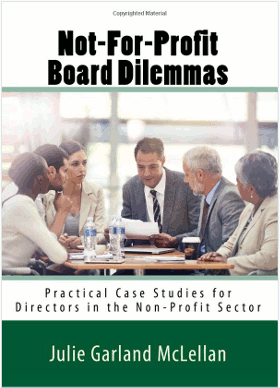|
|
|
|
|
|
|
|
|
Dear reader,
Welcome to the May 2019 edition of The Director’s Dilemma.
These dilemmas are based on real events that have occurred during my twenty years' experience serving on and consulting to boards. This month we look at the role of the chair in a merger that is not proceeding to plan.
A good board adds value in a variety of ways. That includes having all directors think independently and diligently about the possible courses of action and their potential outcomes. Clearly the board in the case study failed the foresight test.
To read this email in a browser, go to www.mclellan.com.au/newsletter.html and click on 'read the latest issue'. I hope you enjoy thinking about the governance and strategic implications of the latest dilemma:
 Kalinda chairs a small disability-sector not for profit company. For almost a year the company has been in friendly merger discussions with a similar company operating in an adjacent geographic area. Kalinda chairs a small disability-sector not for profit company. For almost a year the company has been in friendly merger discussions with a similar company operating in an adjacent geographic area.
Kalinda’s CEO and CFO were elected to the board of the neighbouring company in advance of the merger. Everyone expected the merger to proceed. Kalinda’s CEO and CFO reported that the merger was a major topic of that board’s discussions, but they could not give details as it would be a conflict of interest and they were excluded from most of the discussions.
Now Kalinda has received a letter from the chair of the other board saying the merger is not going ahead because due diligence uncovered some ‘worrying information’. The letter also said the CEO and CFO must resign immediately as it was ‘no longer appropriate’ for them to be directors. Kalinda immediately called the executives who said they had no idea what had happened: They had not been made aware of any issues.
Kalinda’s executives called the CEO of the other company but she refused to talk to them and said the other directors had voted them off in a special meeting three days ago. Kalinda tried calling the other chair but her calls were all declined.
She wants to know what has been found and if there is any possibility of getting the merger discussions back on course. Her company has deferred several strategic projects, incurred legal costs, and refrained from bidding for a government contract so as not to compete against the other company.
What should Kalinda do?
|
|
|
|
Julia's Answer
 Kalinda should identify the actual reasons for the merger failing and analyse whether the show stoppers are on her side, the partner’s side, or connected to a third-party. Kalinda should identify the actual reasons for the merger failing and analyse whether the show stoppers are on her side, the partner’s side, or connected to a third-party.
What if the problem is in her company and not evident to her? It could possibly be known or even invented (?) by the partner company – but they don’t seem to be open to providing any information. They could even think she is involved herself. It could be fraud, financial problems or any other major issues they consider as deal breaking. Kalinda needs to do her homework in her own company, carefully prioritising, and usually with external support. Her aim is to eliminate any potential time bombs quickly and efficiently.
Step two – analysing third party show stoppers on the partner’s side: The partner has been offered more attractive merger conditions by another company – Kalinda should identify the competitor and consider adapting her conditions, or they decided not to merge anymore, e.g. due to changing market circumstances or new, promising chances for business growth without a partner – Kalinda should find out what these could be and what they mean for her. The partner could also think that his and Kalinda’s executives are not a good match in general. In this case Kalinda needs to evaluate the consequences of a future with a merger but without her CEO and CFO.
Kalinda also needs to consider a completely new strategy starting from scratch – without the original target partner, possibly with a different partner or a business model and growth strategy her executive team drives alone. In each case Kalinda should evaluate whether her executive team is capable of delivering the future target performance and adds value with regards to the option/s she finally chooses and whether alternative executives would add more value.
Julia Zdrahal-Urbanek is Managing Partner of AltoPartners Austria and heads their board practice. She is based in Vienna, Austria.
|
|
|
|
Julie's Answer

What a mess!
Kalinda is too far removed from the negotiations. She needs to talk with whoever has been handling the merger discussions from her company’s side and find out what are the issues that have led to this decision. If these are a concern to the prospective merger partner they should be a concern to the board.
She then needs to decide how she is going to move forwards when her two most senior executives are on the other party’s board and thus bound to act in the other party’s interests. Kalinda is in no position to instruct her CEO and/or CFO on whether they should resign; that is a personal decision for them to make. Whilst they are on the other board they cannot act for Kalinda’s board on the merger.
It is the members, rather than the directors, who can vote directors off a board and, until there is a properly constituted members’ meeting they remain on the board unless they resign; they are not off the board simply because the other directors said so!
There should be a draft heads of agreement setting out how the parties will treat each other. Kalinda should reread it and see what it says about the costs of the deal, non-compete on tendering, deferral of projects, and other issues, that have now harmed her company. She needs to consult her company’s legal adviser and find out if they can recover costs or claim damages.
Most important, she needs to schedule a board meeting and build consensus on a way forward. That is a board decision and not hers, as chair, to make. With any merger, acquisition, or divestment, a good board should always have a contingency plan. It is now time to implement it.
Julie Garland McLellan is a non-executive director and board consultant based in Sydney, Australia.
|
|
|
|
Brendan's Answer

Kalinda needs to take a hard look at how they approached this potential and so called “friendly” merger.
Conscious Governance uses a six-step model for assessing partnerships, alliances, mergers and acquisitions: you must have the right strategy, information, timing, price, conditions, and integration.
From the information available, Kalinda, her Board and her executives failed significantly in their duty to their own organisation, especially on the first three items.
Firstly, I hear no clear strategic imperative for the merger to be entertained. It is also puzzling why Kalinda’s CEO and CFO were elected to the other Board. It is puzzling why Kalinda’s and the organisation’s policies allowed them to join the other board as Directors. It is also puzzling, if not troubling, that the other Board facilitated their engagement as Directors, especially while merger discussions were underway.
Conscious Governance also encourages Boards to consider 20 tough questions (copies available on request) before embarking on merger discussions, and hopefully before someone wants to merge with you. One question proposes a $30,000 break fee if the other party pulls out of the merger discussions. This will test how serious they are. It would also would have helped Kalinda’s organisation cover some costs but would not recompense lost business opportunities or contracts.
Brendan Walsh is a Senior Associate at Conscious Governance. He is based in Parkville, Victoria, Australia.
|
|
|
|
Book review - Not-for-Profit Board Dilemmas

Governance is the key driver of performance and accountability for both corporate and not-for-profit Australian companies. Julie Garland McLellan’s dilemmas – now gathered together in this publication - challenge us to think seriously about how we think and act as directors. She presents her material in an engaging way, with a degree of clarity that exposes ways of thinking which will assist both experienced and new directors to fulfil their roles. For the not-for-profit sector, increasing interest in transparency and accountability means that directors must shoulder similar responsibilities to their corporate counterparts. Julie’s writing on critical situations that arise around the board table provides a pedagogical framework in a most enlightening and entertaining way. This book is a timely resource and is a welcome addition to director education.
Reviewed by:
Sue-Anne Wallace, Chair, Australian Council for International Development, and Code of Conduct Chair, Customer Owned Banking Code Compliance Committee
Available at the AICD Bookstore with a discount for members or from Amazon.com.
Julie's news - In April
A few more events in Sydney and a lot of work reviewing board performance and developing a course on conflict resolution for boards kept me happily busy all month. Highlights were the Australian Institute of Company Director’s forum to talk about the issues raised during the Hayne Royal Commission, The Filex Convention (which I attend as a Board Member of Fitness Australia and learn something new at every year), and a visit underground (literally to the coal face) with my mining company board.
On the personal front I enjoyed the great Sydney weather and a lovely trip to Bali over the Easter Holidays.
I am always keen to work more and will be delighted to hear from you if you would like to arrange a board strategy workshop, education session, or board performance review. Just call me on +61 411 262 470 or reply to this email for a discussion of how I might help your board.
Inspirational quote for April - This month my favourite quote is:

I have occasionally felt that the covers of my board pack were too far apart!
Editing for brevity, clarity and simplicity does a lot to improve ease of reading, and retaining, the information. Directors are good at reading (as are most authors); that does not mean we should overwhelm them with lengthy and often superfluous detail in their board papers. Before cutting and pasting think about whether the board really need the information and then write something specific for board needs. A useful book for executives who prepare board papers is Presenting To Boards.
A note on names - A few readers have asked me where I find the names for the protagonists in each case study; I 'borrow' them from people I meet for things that I read. Kalinda is an old Hindu name meaning “Sun”. Our protagonist Kalinda needs to shine some light on what has happened and then get clear about how to take her organisation forwards in a strategically sustainable way.
There is also an Aboriginal version of the name which means “look” or “see”. Our protagonist Kalinda should have looked more carefully into the implications of the board memberships and merger process; she may have seen this problem earlier.
This newsletter - If you have any ideas for improving the newsletter please let me know. If you are reading a forwarded copy please visit my website and sign up for your own subscription.
Suggestions for dilemmas - Thank you to all the readers who have suggested dilemmas. They are greatly appreciated. I will answer them all eventually. I could not write this newsletter without your help and without the generous help of all the experts who respond each month to the case studies.
Be a contributor - If you would like to attempt a response to the dilemmas for publication you will be most welcome. Simply reply to this email and let me know.
Let's connect - I use LinkedIn to share information about boards and directorship with my friends and acquaintances. If you use LinkedIn and we are not yet connected I will welcome a connection from you. You can find me at linkedin.com/in/juliegarlandmclellan.
Let me help you - If you would like me to speak to or train your board, staff, audience and/or group please contact me at julie@mclellan.com.au.
Farewell until the next issue (due 1 June 2019). I look forward to greeting you again then. In the interim I hope you will enjoy health, happiness and hard work.
Enjoy governing your corporations; we are privileged to do what we do!
Best regards,
Julie
Photo Credits:
Personal images in this newsletter are provided courtesy of the contributors, course attendees and conference participants.
Main Photo by mentatdgt form Pexels.
Disclaimer:
The opinions expressed above are general in nature and are designed to help you to develop your judgement as a director. They are not a definitive legal ruling and do not constitute legal advice. Names and some circumstances in the case study have been changed to ensure anonymity. Contributors to this newsletter comment in the context of their own jurisdiction; readers should check their local laws and regulations as they may be very different.
Privacy:
I am privileged to have your contact details and keep them as safely as possible. I will alert you if they are ever accessed by any unauthorised person (the technical staff at ayuda help with publishing and issuing the Director's Dilemma nad have access so they can send the newsletters to you). I do not sell your details to anyone; they are kept only for the intended purpose - sending you this newsletter and helping to build the judgement of company directors by providing a safe way to consider potential responses to real life events.
|
|
|
|
|
|
|
|
|
|
|
|
|
 Kalinda chairs a small disability-sector not for profit company. For almost a year the company has been in friendly merger discussions with a similar company operating in an adjacent geographic area.
Kalinda chairs a small disability-sector not for profit company. For almost a year the company has been in friendly merger discussions with a similar company operating in an adjacent geographic area.
 Kalinda should identify the actual reasons for the merger failing and analyse whether the show stoppers are on her side, the partner’s side, or connected to a third-party.
Kalinda should identify the actual reasons for the merger failing and analyse whether the show stoppers are on her side, the partner’s side, or connected to a third-party.



